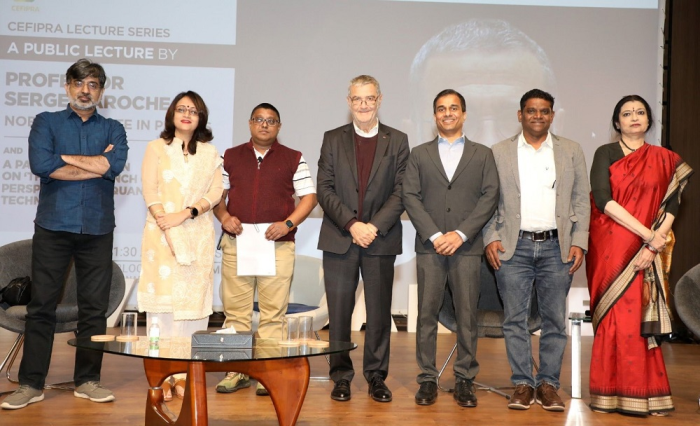Professor Serge Haroche, winner of the 2012 Nobel Prize for Physics, speaking at the Shiv Nadar Institution of Eminence, Delhi-NCR, said, “Although physicists worldwide are trying very hard, we are very far from having a quantum computer. However, what will undoubtedly happen is finding new applications of quantum technology, some of which will be more surprising. Once we deeply understand quantum complexities and entanglement, we can discover more applications that we are not dreaming about today. We should keep ourselves open to all surprises. We can never accurately predict the future because if we do, we are limiting our research.”
Professor Haroche spoke at the Institution as part of a lecture series organized by the Indo-French Centre for the Promotion of Advanced Research (CEFIPRA).
In her welcome address, Dr. Ananya Mukherjee, Vice-Chancellor, Shiv Nadar Institution of Eminence, said that the event marks a special day in the life of the University.
“Research is the backbone of our Institution, and we aspire to produce research that changes the world and fosters an excitement that is powerful and enduring. Research is integrally built into our curriculum. We are privileged to have a research infrastructure in the global south, and we are adding to that infrastructure every day to expand an exceptional research environment. As an Institution of Eminence designated by the Government of India, we wish to engage in the country’s research priorities actively,” said Dr. Mukherjee.
Explaining the origins of quantum research, Professor Haroche recalled how the association between Albert Einstein and Indian scientist Satyendra Nath Bose precisely a century ago, in 1923, helped Einstein develop the Bose-Einstein statistics, which has been the cornerstone of quantum research. “This explains the connection between basic and applied science. What Bose-Einstein statistics explained later gave rise to a new field of physics called atomic interferometry.”
Quashing the hype around the so-called ‘Second Quantum Revolution,’ Professor Haroche said, “It is time we focus on our research and not over-publicizing it because we can rarely predict what the future holds. All we know about is that we need to pursue basic science relentlessly. We must be motivated by our curiosity. The applications emerging several years later will undoubtedly surprise us.”
Earlier addressing the audience, Dr. Didier Raboisson, Attaché for Scientific Cooperation, Embassy of France in India, said, “CEFIPRA offers €4 million for research between India and France, and we also have a grant of €1.7 million to support student mobility from India to France.” He encouraged students and faculty from Indian universities to explore these options for collaborative research.
“Shiv Nadar Institution of Eminence is a young university demonstrating a strong passion for teaching and research. We are delighted to host this lecture here,” said Dr. Nitin Seth, Director of CEFIPRA, in his introductory remarks.
In his introduction to Professor Haroche, Dr. Sanjeev Galande, Dean of School of Natural Sciences, said, “When it comes to the minute components of the universe, one’s usual understanding of how the world works ceases to exist. For a long time, many quantum phenomena could only be observed theoretically. In the 1980s, Professor Serge Haroche designed experiments to study quantum phenomena when matter and light interact. Professor Haroche is a man who followed his dream. With his elementary knowledge of calculus as a child, he could compute complex problems. The astonishing fact that nature follows mathematical laws and the mysterious beauties of the quantum world inspired the child in Professor Haroche to become a quantum physicist.”
The Nobel laureate’s lecture was followed by a panel discussion with three leading quantum physicists in India: Professor Urbasi Sinha of the Raman Research Institute, Bengaluru; Professor Umakant Rapol, Indian Institute of Science Education and Research (IISER), Pune; and Professor Rajamani Vijayaraghavan of the Tata Institute of Fundamental Research, Mumbai. Dr. Subhra Sen Gupta of the Department of Physics at the Shiv Nadar Institution of Eminence moderated the talk. Professor Haroche expressed his appreciation for the work being done in India and the passion with which the scientists spoke about their work.
Signing off, the Nobel Laureate said, “Collaborations are very important, and they should be developed bottom-up – scientists should organically grow their interests. There is much scope for Indo-French cooperation in quantum technology and many other research fields.”
The lecture was attended by approximately 600 people from all over Delhi-NCR.
About the Shiv Nadar Institution of Eminence
The Shiv Nadar Institution of Eminence is a multidisciplinary, student-centric research university established in 2011 by Shiv Nadar, one of Asia’s foremost philanthropists and the founder of HCL, a $12 billion global technology enterprise. The University has four Schools: Engineering; Natural Sciences; Humanities and Social Sciences; Management & Entrepreneurship; and an Academy of Continuing Education. It is the youngest University to be recognized as an Institution of Eminence by the Government of India, a distinct category of higher education institution that strives to achieve global recognition through its teaching and research excellence. It offers undergraduate, master’s, and doctoral programs through its four Schools. The 286-acre residential campus of the Institution is home to an exceptional research environment with faculty drawn from some of the top institutions in the world.

